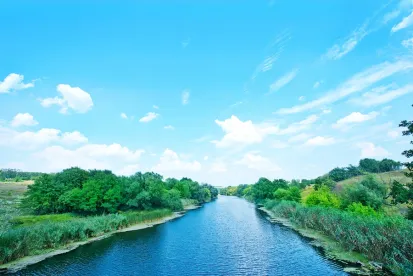Part of a Host of New Administration Initiatives Addressing Tribal Issues
On September 26, 2016, the Environmental Protection Agency (“EPA” or “Agency”) finalized a rule, Treatment of Indian Tribes in a Similar Manner as States for Purposes of Section 303(d) of the Clean Water Act (“Final Rule”), which authorizes tribes to administer the Clean Water Act (“CWA”) section 303(d) program within their reservations. The 303(d) program requires states (and now possibly tribes) to identify lists of impaired waters (“Impaired Waters”) within their jurisdiction and subsequently to create Total Maximum Daily Loads (“TMDLs”) for those waters. TMDLs represent the total amount of pollution Impaired Waters can withstand and still remain in compliance with other EPA CWA programs. The Final Rule affords qualifying tribes “treatment in a similar manner as states” (“TAS”) status to administer the CWA section 303(d) program. Currently, the 303(d) program is generally administered by the EPA on Indian reservations.
While the vast majority of CWA programs are jointly administered by the EPA and state environmental agencies, several CWA programs already have TAS authorization provisions. For example, tribes are authorized under the CWA and EPA’s regulations to develop water quality standards (“WQS”) under CWA section 303(c); receive waste management treatment grants; conduct nonpoint source management; administer the national pollutant discharge elimination system (“NPDES”); regulate the discharge of dredged or fill material under section 404; and direct sewage sludge management programs under section 405. The new Final Rule extends the TAS benefit to the CWA 303(d) program. EPA also has TAS authorization provisions under other environmental statutes such as the Clean Air Act.
The Final Rule becomes effective October 26, 2016, at which point tribes may begin applying for TAS status to administer the 303(d) program on their reservations. Project developers and others seeking CWA permits may encounter several challenges once the Final Rule is in effect. For example, similar to a state’s list of impaired waters and TMDLs, a tribe may choose to develop lists of waters and TMDLs that are more stringent than federal standards. Additionally, it is possible that there will be two TMDLs standards to take into account when seeking permits or other CWA authorizations in certain parts of the country: the state and the tribal standards.
The Final Rule is part of a host of initiatives the Obama Administration is pursuing in its final months to strengthen the government-to-government relationship between the federal government and American Indian tribes. In just the past few months, the EPA has revised its overarching interpretation of the CWA TAS provision, released an interagency agreement on tribal treaty rights to advance tribal sovereignty and self-determination, and announced that it is awarding Native communities $2 million to address Brownfields. Meanwhile, on Monday, the President signed into law the Native American Tourism and Improving Visitor Experience Act (“NATIVE Act”), which requires federal agencies to update their management and tourism plans to include Indian tribes, tribal organizations, and Native Hawaiian organizations. And since early September, in the wake of the Dakota Access Pipeline protests, the Departments of the Interior, Justice and the Army have been reviewing federal permitting and authorization procedures as they relate to tribal consultation. The agencies’ review process is potentially an effort to alter the existing regulatory and statutory schemes. Engagement between the federal government and tribal leaders on the consultation process will officially begin in October (see VNF’s September 29, 2016 Alert). The final year of this Administration has already been marked by broad support for tribal sovereignty and authorization and, as the 303(d) TAS Rule demonstrates, there is likely more to come.
Background on the CWA TAS Program
The CWA defines “Indian tribe” to mean any tribe, band, group or community recognized by the Secretary of the Interior and exercising governmental authority over a federal Indian reserve. Alaska Native Organizations are also eligible for TAS authorization. In order to qualify for TAS authorization: (1) a tribe must be federally recognized and have a governing body to carry out the tribe’s governmental duties and functions; (2) the CWA functions the tribe seeks to administer must be related to the management and protection of the water resources that are within the tribe’s jurisdiction; and (3) in the EPA’s discretion, the tribe must be capable of carrying out the CWA program functions and duties. CWA section 518(e)(2) enumerates twelve CWA programs for which TAS authorization is available, including section 303.
A tribe achieves CWA TAS status by applying to the EPA Region where the tribe’s reservation is located. EPA’s TAS 303(d) program application process mirrors the common section 518(e)(2) requirements. Generally, a TAS application must include the following information: (1) a statement that the applicant is a federally recognized Indian tribe that has a “governing body carrying out substantial duties and powers”; (2) a description of the tribe’s capabilities to effectively administer the environmental program for which they seek TAS authorization; and (3) a descriptive statement of the tribe’s jurisdiction to regulate the environmental resources at issue. The Final Rule clarifies that neither EPA’s regulations, nor the CWA, imposes a timeframe on EPA’s review of a TAS application.
Once a tribe receives its CWA TAS status, it can subsequently apply to EPA to administer other CWA programs. According to the Final Rule, 53 tribes have already obtained authority to administer the section 303(c) WQS program using the same application process detailed above. However, tribes are not required to have WQS in place for waters on their reservations prior to applying for 303(d) program TAS authorization – although it is recommended by the Agency in the Final Rule. Likewise, tribes do not have to have been granted TAS authorization for any other CWA program prior to applying for the 303(d) TAS authorization. The Final Rule includes a helpful step-by-step approach for tribes interested in applying for 303(d) TAS authorization.
Background on Impaired Waters and TMDL Program
In addition to technology-based standards that are widely associated with the EPA’s NPDES program, the CWA also imposes water-quality based effluent limitations through section 303(c). Currently, states are required to develop WQS for individual water bodies by designating uses for those waterbodies. Designated uses include: recreation, aquatic life, agriculture, and water supply. Under the related 303(d) program, states are also required to identify Impaired Waters within their jurisdictions that are unable to meet the designated uses and WQS and then develop TMDLs to achieve compliance with the WQS. The EPA must approve a state’s list of Impaired Waters and its TMDLs. As noted above, the Final Rule extends the 303(d) program so that tribes can develop Impaired Waters lists and TMDLs for water bodies within their jurisdictions.
TAS Responsibilities under the 303(d) Program
The Final Rule includes a list of 303(d) program responsibilities that tribes would assume and implement if granted TAS status to administer the program. First, eligible tribes will be required to identify Impaired Waters and submit this list every two years to the EPA. The tribe’s list of Impaired Waters would have to include all impaired and threatened waters within the scope of the tribe’s TAS authorization, i.e., within the tribe’s jurisdiction. The tribe will also be required to utilize and evaluate all “existing and readily available information” in developing the Impaired Waters list.
Second, tribes will be responsible for establishing and submitting TMDLs for all waters on its Impaired Waters list. TMDL refers to the maximum amount of pollution than an Impaired Water body can receive and still meet its designated use. The way in which a state or tribe calculates its TMDLs is subject to public review.
Finally, tribes will have to undergo the EPA approval process. Once the EPA receives an Impaired Waters list or TMDL, it is required to approve or disapprove the submission within 30 days. If either is disapproved, the EPA must establish an alternative Impaired Waters list or TMDL within 30 days of its disapproval.
Geographical Scope of Tribal Jurisdiction to Administer the 303(d) Program
The CWA limits tribal TAS authorization to water resources within a tribe’s reservation. The CWA does not authorize tribes to administer any programs pertaining to any “non-reservation Indian country or any other type of non-reservation land.” According to the Final Rule, it is EPA’s longstanding interpretation that reservations include both formal reservations (reservations established through federal treaties, statutes or Presidential Executive Orders) and informal reservations (such as Indian allotments, including right-of-ways and trust lands). It is EPA’s position that it will not apply a “checkerboard approach” to determine jurisdiction for purposes of its TAS programs but rather once EPA determines a tribe has jurisdiction over the land the tribe seeks to regulate under the CWA TAS program, the EPA will find that the tribe has jurisdiction to administer other CWA programs – regardless of whether the tribe or a non-tribal member owns the land. There are a variety of court cases that have upheld EPA’s tribal TAS authorizations. However, the jurisdictional issue is one of the most contentious issues surrounding TAS authorizations and will likely be the subject of further disputes.
Implications of the Final Rule
The Final Rule addresses multiple concerns that were raised in response to the proposed rule. Several concerns were raised related to tribal jurisdiction and whether tribes would be able to administer TAS programs over lands where the tribes had contractually given up their rights to regulate that land or over lands where states have primary jurisdiction to administer EPA programs. EPA found that these concerns were outside the scope of the rulemaking and that such concerns would be individually addressed when and if a tribe applied for TAS authorization. It is easy to imagine, however, that jurisdictional issues will become more prevalent as additional tribes apply for and are granted TAS authorizations. According to the Final Rule, a tribe’s TAS application, including its assertion of jurisdiction, will continue to be subject to public notice and comment proceedings.
The Final Rule will also have practical implications for the 303(d) program. As mentioned above, project developers and others seeking CWA permits and authorizations may be impacted by multiple regulatory regimes. It is possible that a tribe could decide to designate more waterbodies for “higher uses,” i.e., fishing and swimming, than their current state designations, resulting in a greater number of waterbodies listed as Impaired Waters, and to set more stringent TMDLs for those waterbodies. This scenario has already played out in the WQS context under section 303(c) – in 1996 the U.S. Court of Appeals for the Tenth Circuit upheld EPA’s determination that an Indian tribe’s WQS that were more stringent than those established by the State of New Mexico were lawful under the EPA’s TAS program.




 />i
/>i

